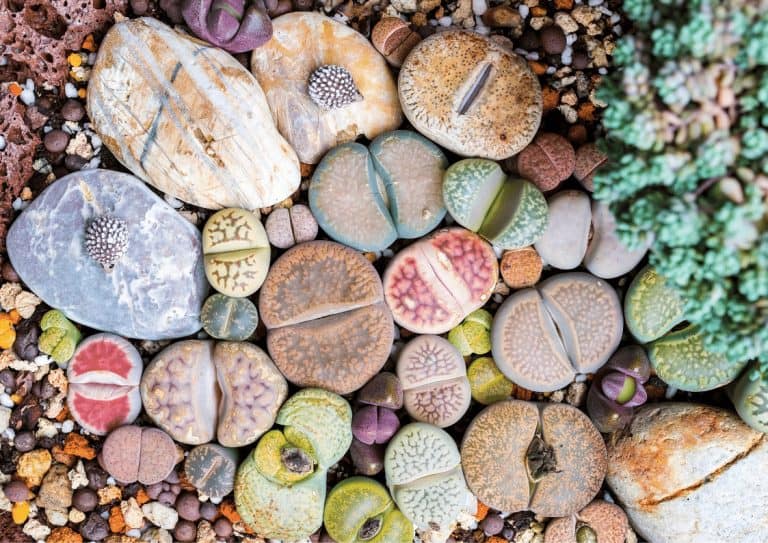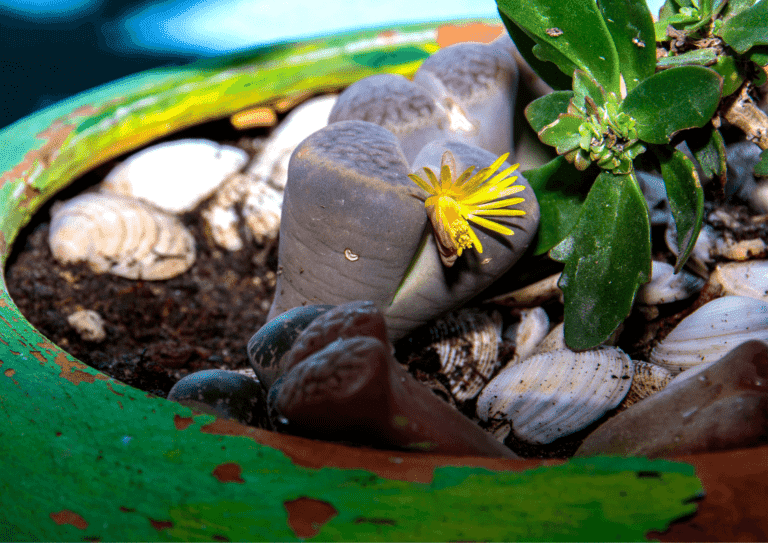Patience Is A Virtue: How Long Do Lithops Take To Grow?
- Lakeisha Ethans
- June 12, 2022
If you buy something using the retail links in our articles, sometimes we earn a small affiliate commission. This does not impact the products we recommend.
Lithops plants are a unique ice plant genus boasting over 145 varieties across 37 known species. They’re famously referred to as living stones or pebble plants due to their striking resemblance to rocks. They are quite low-maintenance in nature, requiring highly specific care but in minimal amounts.
Lithops plants are famously long-lived and have a regular, easy-to-understand life cycle and growth timeline that makes them attractive options for first-time growers. But, as with many plants that have long lifespans, growing them requires quite a bit of patience. It’s reasonable to be concerned if your plant doesn’t seem to be growing very quickly.
Lithops plants can take up to three months to germinate as seedlings and may take between three and five years to reach full maturity before flowering. As with all plants, growth speed of Lithops is largely determined by abiotic factors such as access to nutrients and climate.
In this article, we’ll broadly cover topics concerning the Lithops lifecycle and the factors that go into ensuring continual healthy growth. The questions we’ll answer include:
- How quickly do Lithops plants grow under optimal environmental factors?
- What is the annual growth cycle of a Lithops plant and how must plant care be tailored for each stage of growth?
- Do different Lithops species have different growth timelines?

How quickly do Lithops plants grow under optimal environmental factors?
To improve the chance of successful germination, Lithops seeds should be moistened with a gentle, fine spray before being lightly covered by a free draining potting mix. Plastic wraps that seal over the top of the pot, or propagators help by retaining heat and humidity, both of which encourage the seed to germinate faster.
You can expect germination to take between 2 – 12 weeks, depending on the environment and care that the Lithops plant receives. Seedlings can be moved away safely once they reach large enough sizes to handle, which may take 6 – 12 months.
At this point, it’s all about patience and environmental factors.
Lithops plants take between three and five years to reach full maturity, at which point they begin producing flowers. Maximum growth may be reached at that point or many years later, depending on the individual species and how many leaves it is capable of pushing out.
Adult plants may be capable of further growth to a maximum size and leaf number, but for the most part, you should expect that once it reaches maturity an adult Lithops is pretty much as large as it is going to get.
For optimal growth a Lithops plant should receive four or five hours of daily direct sunlight in early hours followed by partial shade as afternoon rises. Good soil drainage is absolutely crucial as well when it comes to ensuring growth without rot or pests.
Most Lithops plants happily thrive in the same spot for one or two decades with no issues. Overall, they are known to live for up to forty or fifty years(!), depending on the care they receive.
Our Favorite Succulents And Supplies On Etsy
What does the Lithops annual growth cycle look like?
Lithops plants have a unique annual growth cycle that requires specific but minimal care for best results.
Spring is one of the two Lithops growing seasons. In already-grown Lithops, this is when old leaves fully die out in preparation for a new growth year. Old leaves will shrivel entirely and can be removed. Mature plants may push out flowers during this season, but this usually happens in autumn, not spring.
The plant should then be watered lightly during spring, promoting new growth of new buds and fattening leaves with stored water in preparation for dormancy. This is a great time to replant a Lithops plant or germinate new seeds.
Summer is when a Lithops plant is dormant. Some people choose to plant new seeds at the end of this season, giving the seeds time to germinate before the next growing season. The plant uses the water it received in spring to support itself.
The plant wants a totally bone-dry, water-free summer and should not be watered or messed with during this period. Watering should only be done if you notice wrinkling of existing leaves, and even then it should be minimal, without drenching the pot. Incorrect watering may lead to root rot.
Next comes autumn, which is another growing season for a Lithops plant. This is another good time to propagate or germinate the flora. This is when mature Lithops plants produce flowers and a split begins to form in their leaves as they prepare to push out new leaves for the next year.
Autumn is usually when Lithops plants need the most water to be fattened for further dormancy. The exact amount of water needed differs from species to species, but you usually need to completely drench soil whenever the plant’s leaves become overly wrinkly.
Finally, in winter, the Lithops plant enters dormancy once more. The plant requires little to no water at this point, expecting a dry winter. It uses its old leaves as a source of water for new leaves, thus slowly shriveling the old leaves in preparation for shedding and the next year.
Winter is the worst time to plant new Lithops seeds or propagate any cuttings. This is a season best left for watching as your Lithops sheds its old leaves in favor of new growth. It can be concerning to watch shriveling, but this is part of the natural life cycle of the plant.

Do different Lithops species have different growth timelines?
There are 37 known species of Lithops, and it’s natural to expect some variation amongst the family in terms of growth. However, these variations don’t necessarily lend themselves to drastically different speeds of growth and development.
For the most part, Lithops plants have similar growth timelines and can be expected to grow at a similar rate. Variations often have to do with growing conditions, climate, and environment, or may just be due to the plant’s home environment or parent plant’s genes. The variance in a single species is greater than the variance between species.
The primary variation lies in how long it takes for a Lithops to reach its maximum growth, or at what point it is capable of pushing forward new leaves beyond its normal cluster. But, even then, there’s no set, definite end point for any given species. For example, Lithops Bromfieldii itself can reach its maximum anywhere between 2 – 5 years.
The speed of flowering can also differ, but once again, not by an amount that is worth drastically separating and comparing different species of Lithops plants.
When it comes to comparing Lithops it’s much better to determine their differences in care requirements than to compare their growth speeds and timelines. Water requirements, soil preferences, and lighting needs are more likely to differ from plant to plant. Providing good growing conditions will always improve growth speed.
Take home message
Lithops grow relatively quickly for such a long-lived plant, and you can get a fully mature, flowering plant from seed in just three to five years.
While there are numerous Lithops species, the fact is that variation in growth speed and cycles are more related to a Lithops’ environment than its type. Ensuring the correct amount of watering, soil, and sunlight exposure are central to promoting healthy, speedy growth.

Lakeisha Ethans
Houseplant Writer
Mother to two humans and hundreds of plant babies. Lakeisha uses her 15 years of experience as a content writer to specialise in simplifying what you need to know to grow and care for all indoor plants.
Similar Posts
Are Calathea Houseplants Poisonous To Cats? {SOLVED}
We explore whether it safe to introduce Calathea into your home office should you work from home alongside your feline friend.
The Best Plants To Keep On Your Office Desk
With the huge choice of indoor plants available for sale these days it's pretty easy to become quickly overwhelmed when searching for a desktop plant that's just right for your own office...



